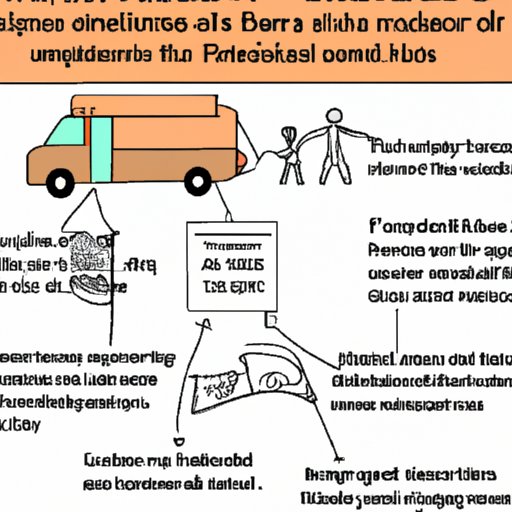Introduction
Subsidized health insurance is a type of health insurance coverage that is provided to individuals who qualify based on their income level. It is designed to help those who may not be able to afford private insurance or may be unable to access employer-sponsored plans. This article will explore what subsidized health insurance is, the benefits of having it, the eligibility requirements and the cost of the coverage. Additionally, it will compare it to other types of health insurance and provide alternatives.

Explaining What Subsidized Health Insurance Is
Subsidized health insurance is a form of health insurance coverage that is offered to eligible individuals based on their income level. It is designed to help those who may not be able to afford private insurance or may be unable to access employer-sponsored plans. Subsidized health insurance can include a variety of different coverage types such as Medicaid, Medicare, CHIP, and Affordable Care Act (ACA) plans.
Medicaid is a federal and state program that provides medical coverage for low-income individuals, including pregnant women, children, seniors, and people with disabilities. Medicare is a federally funded program that provides health care coverage for people over 65 years old, or younger people with certain disabilities. The Children’s Health Insurance Program (CHIP) is a federal and state program that provides health care coverage for children in families that make too much money to qualify for Medicaid but cannot afford private health insurance.
The Affordable Care Act (ACA) provides subsidies to help individuals purchase health insurance through the Health Insurance Marketplace. These plans are required to cover essential health benefits, such as preventive care, doctor visits, hospitalizations, mental health services, and prescription drugs. The amount of subsidy an individual receives depends on their income level.
Benefits of Subsidized Health Insurance
Subsidized health insurance provides numerous benefits to qualified individuals. These include lower costs, increased access to quality care, and coverage for those who are uninsured or underinsured.
Lower Cost for Qualified Individuals
Subsidized health insurance is often significantly less expensive than private health insurance. According to a study by the Kaiser Family Foundation, subsidized health insurance plans through the ACA marketplace had monthly premiums that were, on average, 83 percent lower than those of employer-sponsored plans. For qualified individuals, this makes health insurance more affordable and accessible.
Coverage for Uninsured or Underinsured Individuals
Subsidized health insurance also provides coverage for individuals who are uninsured or underinsured. This includes individuals who have lost their job-based health insurance, are ineligible for Medicaid, or are unable to afford private insurance. Subsidized health insurance can help these individuals access quality health care at a lower cost.
Access to Quality Care
Subsidized health insurance plans typically offer access to quality health care services. Most plans include coverage for preventive care, doctor visits, hospitalizations, mental health services, and prescription drugs. This makes it easier for individuals to get the care they need without having to worry about the cost.

Eligibility Requirements for Subsidized Health Insurance
In order to qualify for subsidized health insurance, individuals must meet certain eligibility requirements. These requirements vary depending on the type of plan and the state where the individual lives. Generally, individuals must meet the following criteria:
Income Level
Income level is one of the most important factors when determining eligibility for subsidized health insurance. Each plan has specific income guidelines that an individual must meet in order to qualify. For example, in order to qualify for Medicaid, an individual must have an income that is below the poverty line.
Age
Age is another factor used to determine eligibility for subsidized health insurance. For example, Medicare is only available to individuals who are 65 years of age or older, while CHIP is only available to children.
Residency Status
Residency status is also taken into account when determining eligibility for subsidized health insurance. Some plans, such as Medicaid, require individuals to be U.S. citizens or legal residents in order to qualify.

Cost of Subsidized Health Insurance
The cost of subsidized health insurance varies depending on the type of plan, the state where the individual lives, and the individual’s income level. Generally, there are three main costs associated with subsidized health insurance: premiums, deductibles, and co-pays and co-insurance.
Premiums
Premiums are the monthly payments that individuals must pay in order to maintain their health insurance coverage. Depending on the type of plan, these payments can be subsidized, meaning that individuals may be eligible for discounts or tax credits that can help reduce the cost of the premium.
Deductibles
A deductible is the amount of money that an individual must pay out-of-pocket before their health insurance coverage kicks in. Deductibles vary depending on the type of plan, but typically range from $1,000-$5,000. Some subsidized health insurance plans may have lower deductibles for individuals with lower incomes.
Co-pays and Co-insurance
Co-pays and co-insurance refer to the percentage of health care costs that an individual must pay after meeting their deductible. These costs can vary depending on the type of plan, the services received, and the state where the individual lives. Some subsidized health insurance plans may have lower co-pays and co-insurance for individuals with lower incomes.
Comparing Subsidized Health Insurance to Other Types of Coverage
When comparing subsidized health insurance to other types of coverage, it’s important to consider the differences in cost, coverage, and access. Here is a brief overview of the differences between subsidized health insurance and other types of coverage:
Employer-Sponsored Plans
Employer-sponsored plans are typically more expensive than subsidized health insurance plans. They also often have higher deductibles and co-pays. However, they typically offer better coverage and access to more providers than subsidized health insurance plans.
Individual Market Plans
Individual market plans are private health insurance plans that can be purchased directly from an insurer. They are typically more expensive than subsidized health insurance plans, but may offer better coverage options. Additionally, some insurers may offer discounts or tax credits for individuals who qualify for subsidized health insurance.
Short-Term Plans
Short-term health insurance plans are typically less expensive than subsidized health insurance plans, but they often have limited coverage and may not cover pre-existing conditions. Additionally, these plans generally do not include coverage for preventive care or prescription drugs.

How Subsidized Health Insurance Works
Subsidized health insurance plans work similarly to other types of health insurance plans. Individuals must enroll in a plan and then file claims for any health care services they receive. Most plans also require individuals to use network providers in order to receive coverage.
Enrollment Process
The enrollment process for subsidized health insurance plans varies depending on the type of plan. Generally, individuals must complete an application and provide proof of income, residency, and other required documents in order to apply. Once approved, individuals can begin using their coverage.
Claim Filing
Once enrolled in a subsidized health insurance plan, individuals must file claims for any health care services they receive. This includes filing claims for prescriptions, doctor visits, hospital stays, and other medical expenses. Claims must be filed with the appropriate insurer in order to receive coverage.
Network Providers
Most subsidized health insurance plans require individuals to use network providers in order to receive coverage. Network providers are health care providers, such as doctors and hospitals, that have agreed to accept the terms of the plan. Using network providers can help ensure that individuals receive the highest level of coverage possible.
Alternatives to Subsidized Health Insurance
There are several alternatives to subsidized health insurance, including Medicaid, Medicare, and CHIP. These programs provide health care coverage to individuals who may not qualify for subsidized health insurance.
Medicaid
Medicaid is a federal and state program that provides health care coverage for low-income individuals, including pregnant women, children, seniors, and people with disabilities. To qualify, individuals must meet certain income and residency requirements.
Medicare
Medicare is a federally funded program that provides health care coverage for individuals who are 65 years of age or older, or younger individuals with certain disabilities. To qualify, individuals must meet certain age and residency requirements.
CHIP
The Children’s Health Insurance Program (CHIP) is a federal and state program that provides health care coverage for children in families that make too much money to qualify for Medicaid but cannot afford private health insurance. To qualify, individuals must meet certain income and residency requirements.
Conclusion
Subsidized health insurance can be a great option for individuals who are unable to afford private health insurance or access employer-sponsored plans. It provides lower costs, increased access to quality care, and coverage for those who are uninsured or underinsured. In order to qualify, individuals must meet certain eligibility requirements, such as income level, age, and residency status. Additionally, there are several alternatives to subsidized health insurance, such as Medicaid, Medicare, and CHIP. When choosing a plan, it’s important to consider all of your options and find the right fit for your needs.
(Note: Is this article not meeting your expectations? Do you have knowledge or insights to share? Unlock new opportunities and expand your reach by joining our authors team. Click Registration to join us and share your expertise with our readers.)
